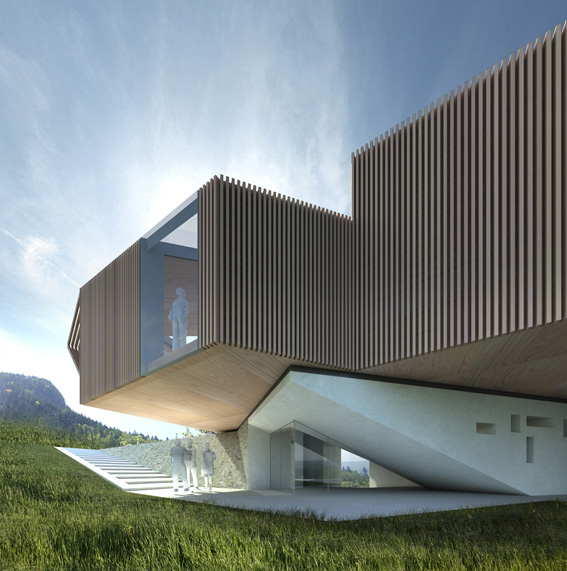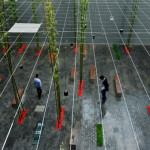FRANCESCO GATTI
Special interview for CityVision magazine.
Francesco, does exist a common line on your projects?
Reds use is one of the most evident aspects, but probably there’s somethin invisible that joint together the Automobile Museum and In Factory, is this true?
FG: It’s true, maybe I’ve put too much red. I like contrasts and red is the best way to have them. Also black and white, anyway I think that with simplicity is easier to read the project. Probably I’m not able to designing with colors, you can see that also in the way I wear clothes, greytones on the background and then a red element, shoes or underwear. I’m monotone. Going back to the answer, to band together all my projects is the simplicity, that is a very difficult and complicated thing to achieve, but when you find the idea it comes out fast and powerful.
What emotions tell your projects?
Probably the images with which you found yourself, face to face, in everyday life in a metropolis like Shanghai are quite distant from the stimuli of the city where you lived for 31 years, which atmosphere did you decide to tell us with your building folds?
FG: Short emotions, powerful and easy to inject. I think that’s what we want, we grew up watching television, bombarded with imges from morning to evening. From this point of view, Rome is more relaxed than Shanghai, but I believe that globalization does look more and more similar our lives. For me that I want to barbarize me as possible, Shanghai is my great teacher of life. I think this is the only way I can really understand what people want from my architecture and enjoy tomorrow in a constructive way.
Shanghai is cold, glittering, cruel. The building will dominate. There’s a kind of frenzy atomic activity that goes on, the more furious is the step, smaller is the spirit. A continue fremito, that can also happen in a provetta.
Nobody knows the purpose. No one directs the energy. Superb. Bizarre. Disconcerting. A terrible reactive impulse without coordination.
The East suggest an image of woman very different from what we know, the famale population has never represented a form of inspiration for your projects?
FG: The woman is the reason for everything I do in my life and I believe that is the reason led me to be an architect and that will take me to leave architecture, then I remind the Manuel Fantoni’s image from Borotalco movie and I apologize if I violated the poetry of your question.
Knowing that university is at the most a place to sharing experience between students and a bad gym for architectural practice, where do you think can be hosted the future creative theaching?
FG: You can find your teachers everywhere: on Facebook, on tv, between friends, on books…recently I learned a lot in the South Park cartoon and thanks to a perfect stranger on Facebook. When I was young I was not so barbaric and I had to be sadisfied by school’s professors, now is better and I’m out of intellectual elite.
Crisis is a term widely used at present, beyond the economic factor that is only one of many issues. How would you suggest to overcome the creative stalemate, innovative, the experimental resistance to any kind of emotional momentum that characterize the italian and roman architectural scene?
FG: I’m happy from the crisis, I think is an evolution. Architecture quality is dying and leaving space to builders, restaurants are closing to give space to fast foods and fortunately we don’t listen classical music anymore, but we inject drum’n’bass. Everything is in the knowlegde to convert what we were considering having a soul with something without soul and closer to what we really are today (architects are doing this well) and I suggest Baricco last essay.
As a City Vision jury member, what is your opinion on young protagonist of the roman architecture scene? Do you think that comparing with an ancient culture as Rome, so heterogeneous and full of symbolic contents is a vantage or a limit to whom is looking out at the complex architectural world?
FG: I think it’s an advantage because it’s certainly more fun raping the Vatican and the old roman “babbioni”, rather than an american or chinese wasteland, where you cannot so amuse yourself in the plunder of the old empire. In Rome today, young people are the only ones able to do the architects, the only ones who can really understand what their generation wants, generation that will be the alone user of the building that will begin to built today.
True architecture avoids precepts, idols, dogmas, the ideal to cultivate is the courage one. Your story tell us about a guy that crossed the world to follow his passions. Do you think that the relationship between the young architect generation and the “masters” can help or hinder an important renewal in Italy?
FG: The masters’ problem is that they gave us a story that talks about invention, upgrade, change and revolution. We look, on our history books, at those people who have invented the avantguards and we feel sorry if we cannot invent another one to give a chance to contemporary architecture. But today I don’t think “invent” can be the right direction, look at music that is always ahead; contemporary music hasn’t new composers. Today we better understand clonation or the cloned object mutation. Art dosen’t move vertically on its research but moves horizontally, shifting existent elements.
Today we have another problem, everything moves faster than in the past, before student was living in the same master’s era so that he can teach him something good for its life, today the master has to be picked in small quantities, because he talks about an already old era. Let’s take our masters as we take our history books.
interview by Giorgia Sborlino Garcia
Related Posts :
Category: Article
Views: 4092 Likes: 0
Tags: francesco gatti , gatti , office , red object , shanghai
Comments:
Info:
Info:
Title: FRANCESCO GATTI
Time: 17 dicembre 2010
Category: Article
Views: 4092 Likes: 0
Tags: francesco gatti , gatti , office , red object , shanghai









